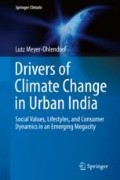Abstract
The first research question deals with the average level and structure of consumption-based personal-level GHG emissions (carbon footprint) in Hyderabad: “What is the average consumption-based personal carbon footprint in Hyderabad and what is the sector-specific structure of personal-level GHG emissions being emitted in Greater Hyderabad?”
Access this chapter
Tax calculation will be finalised at checkout
Purchases are for personal use only
Notes
- 1.
The author of this study has borrowed some of the questionnaire items and adapted these to the Indian context (see Sect. 4.2.4.1).
- 2.
Initially, this research step was considered by the author, but due to financial and time constraints, it was discarded in the end.
- 3.
References
Ananthapadmanabhan G, Srinivas K, Gopal V (2007) Hiding behind the poor: a report by Greenpeace on climate injustice. Greenpace India Society, Bangalore
Backhaus K (2011) Multivariate Analysemethoden: Eine anwendungsorientierte Einführung, 13th edn. Springer, Berlin
Bernard HR (1994) Research methods in anthropology. Qualitative and quantitative approaches, 2nd edn. Sage, Thousand Oaks
Bhoyar SP, Dusad S, Shrivastava R, Mishra S, Gupta N, Rao AB (2014) Understanding the impact of lifestyle on individual carbon-footprint. Procedia Soc Behav Sci 133:47–60
Bilharz M (2009) “Key Points” nachhaltigen Konsums: ein strukturpolitisch fundierter Strategieansatz für die Nachhaltigkeitskommunikation im Kontext aktivierender Verbraucherpolitk, Wirtschaftswissenschaftliche Nachhaltigkeitsforschung, 2nd edn. Metropolis-Verl, Marburg
Brander M, Sood A, Wylie C, Haughton A, Lovel J (2011) Electricity-specific emission factors for grid electricity (Technical Paper). Ecometrica
cBalance (2010) GHG inventory report for electricity generation and consumption in India. Pune
Chemnitz C, Becheva S (2014) Meat atlas – facts and figures about the animals we eat. Heinrich Boell Foundation; Friends of the Earth, Berlin
Climate Change Leadership Fellowship (2008) Transitions in practice. Climate Change Leadership Fellowship and Economic and Social Research Council (ESRC). URL: http://www.lancaster.ac.uk/staff/shove/transitionsinpractice/tip.htm. Accessed 25 July 2016
Creswell JW (2003) Research design: qualitative, quantitative, and mixed method approaches, 2nd edn. Sage Publications, Thousand Oaks
de Haan G, Lantermann ED, Linneweber V, Reusswig F (2001) Typenbildung in der sozialwissenschaftlichen Umweltforschung. VS Verlag für Sozialwissenschaften, Wiesbaden
Devi SM, Balachandar V, Lee SI, Kim IH (2014) An outline of meat consumption in the Indian population – a pilot review. Korean J Food Sci Anim Res 34:507–515
Drews S (2011) Aviation and environment. Centre for Science and Environment, Delhi
Flick U (2006) An introduction to qualitative research, 3rd edn. SAGE, London
Fromm S (2010) Datenanalyse mit SPSS für Fortgeschrittene 2: Multivariate Verfahren für Querschnittsdaten. VS Verlag für Sozialwissenschaften/GWV Fachverlage GmbH Wiesbaden, Wiesbaden
Gadgil M, Guha R (1995) Ecology and equity: the use and abuse of nature in contemporary India. Penguin Books, New Delhi
Grunewald N, Harteisen M, Lay J, Minx J, Renner S (2012) The carbon footprint of Indian households. Presented at the 32nd General Conference of The International Association for Research in Income and Wealth
Jeuland MA, Pattanayak SK (2012) Benefits and costs of improved cookstoves: assessing the implications of variability in health, forest and climate impacts. PLoS One 7:e30338
Kluckhohn C (1944) Mirror for man: a survey of human behavior and social attitudes. Fawcett, Greenwich
Mawdsley E (2004) India’s middle classes and the environment. Dev Chang 35:79–103
Mawdsley E (2006) Hindu nationalism, neo-traditionalism and environmental discourses in India. Geoforum 37:380–390
MoEF (2010) Climate change and India: a 4x4 assessment. A secoral and regional analysis for 2030 (no. 2), Indian Network for Climate Change Assessment (INCCA). Ministry of Environment & Forests, Government of India, New Delhi
National Sample Survey Organisation (2012) Energy sources of Indian households for cooking and lighting 2009–10, NSSO 66th Round
Nelson LE (2000) Purifying the earthly body of God: religion and ecology in Hindu India. D. K. Printworld, New Delhi
Peters V, Reusswig F, Altenburg C (2013) European citizens, carbon footprints and their determinants – lifestyles and urban form. In: Khare A, Beckmann T (eds) Mitigating climate change. Springer-Verlag, Berlin, pp 223–245
Poferl A (1998) Wer viel konsumiert, ist reich. Wer nicht konsumiert, ist arm. Ökologische Risikoerfahrung, soziale Ungleichheiten und kulturelle Politik. In: Berger PA, Vester M (eds) Alte Ungleichheiten Neue Spaltungen. VS Verlag für Sozialwissenschaften, Wiesbaden, pp 297–329
ReportLinker (2015) India air conditioners market forecast and opportunities, 2020 [WWW Document]. URL: http://www.reportlinker.com/p0881690-summary/India-Air-Conditioners-Market-Forecast-Opportunities.html. Accessed 7 Oct 2015
Shove E (2003) Comfort, cleanliness and convenience: the social organization of normality, new technologies/new cultures. Berg, Oxford
Shove E, Pantzar M, Watson M (2012) The dynamics of social practice: everyday life and how it changes. Sage, Los Angeles
Singh DP, Dalei NN, Raju TB (2016) Forecasting investment and capacity addition in Indian airport infrastructure: analysis from post-privatization and post-economic regulation era. J Air Transp Manag 53:218–225
Venkataraman C, Habib G, Eiguren-Fernandez A, Miguel AH, Friedlander SK (2005) Residential biofuels in South Asia: carbonaceous aerosol emissions and climate impacts. Science 307:1454–1456
Verma A, Velmurugan S, Singh S, Gurtoo A, Ramanayya TV, Dixit M (2015) Urban mobility trends in Indian cities and its implications. In: Gurtoo A, Williams C (eds) Developing country perspectives on public service delivery. Springer India, New Delhi, pp 95–116
Walker G, Shove E, Brown S (2014) How does air conditioning become “needed”? A case study of routes, rationales and dynamics. Energy Res Soc Sci 4:1–9
Schendera CFG (2010) Clusteranalyse mit SPSS: Mit Faktorenanalyse. Oldenbourg Wissenschaftsverlag, München.
NSSO (2001) Concepts and Definitions Used in NSS. National Sample Survey Organisation, Government of India. New Delhi.
Author information
Authors and Affiliations
Rights and permissions
Copyright information
© 2019 Springer International Publishing AG, part of Springer Nature
About this chapter
Cite this chapter
Meyer-Ohlendorf, L. (2019). Discussion. In: Drivers of Climate Change in Urban India. Springer Climate. Springer, Cham. https://doi.org/10.1007/978-3-319-96670-0_7
Download citation
DOI: https://doi.org/10.1007/978-3-319-96670-0_7
Published:
Publisher Name: Springer, Cham
Print ISBN: 978-3-319-96669-4
Online ISBN: 978-3-319-96670-0
eBook Packages: Earth and Environmental ScienceEarth and Environmental Science (R0)

